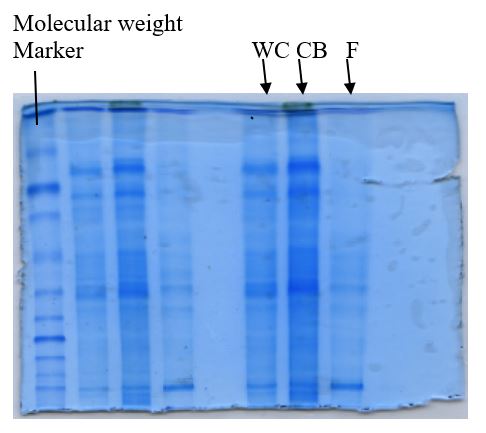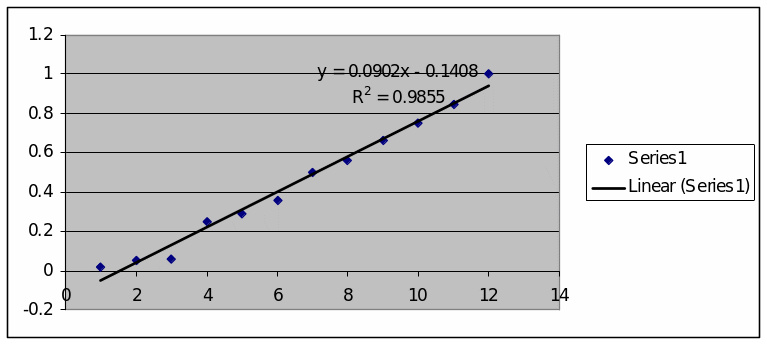Objective
The experiment aimed at isolating flagella protein and carrying out SDS electrophoresis.
Motile flagella and cilia are microtubule-based structures highly organized, comprising approximately 250 proteins. The flagella and ciliary components are found in vertebrates and other eukaryotic organisms. Studies using Chlamydomonas reinhardtii have revealed that most of flagellar proteins assemble into complexes in the cell’s cytoplasm. Radial spokes inner arm dynein and dynein flagella components reassemble. This is per the research done by [FOWKES et al 1998], [QIN et al 2004] and [PIPERON 2004].
Intra-flagella transport revealed in a model of both membrane and non-membrane bound flagellar protein shuttling between the cytoplasm and flagellar compartments. Accumulations of proteins for the flagella occur in the cytoplasm. Here interaction between the proteins and intra-flagella transport takes place. Absence of intra-flagella transport kinesin results to cells with stubby flagella. This suggests that IFT is necessary for the transport and assembly of each and every axonemal component. The final assembly of proteins takes place after the proteins enters the flagellar compartment.
Materials
Chalydomonas reinharditii culture, Centrifuge, Pipettes, Ice, SDS polyacrylamide gel,
HEPES-10mM 4 (2-hydroxyethyl)-1-piperazinethanesulfonic acid pH 7.4
HMDS- 10mM HEPES, 5nM MgSO4, 1mMDTT, 4% sucrose, pH 7.4 ,HMDES-10mM HEPES, 5mM MgSO4, 1mMDTT, 2mM EGTA and ImM PMSF, 4% sucrose pH7.4
HMDEK-30mM HEPES, 4% mM MgSO4, 1mMDTT, 0.5mM EGTA and I mM PMSF, 25mM CH3COOK, Ph 7.4, 50mM Dibucaine
Procedure
- Washing culture to concentrate ‘Chamy’ culture.
- From 20ml cell suspension, keep 1mml aliquot for protein analysis and electrophoresis. Label the sample WC (whole sample).
- Spin the cells for 8minutes at 1300xg in a clinical centrifuge. Aspirate to remove the supernatant and re-suspend the washed cells in 5ml of cold HMDS.
- Add 0.5ml of 50mM dibucaine to the cells and mixed by swirling. This makes cells lose their flagella.
- Add 0.5ml of cold HMDES and mix gently. Spin cells at 2000xg for 5minutes at 4 degrees. The cold pellet contains the cell bodies. Re-suspend the pellet in 2ml of ice-cold HMDEK. Label the tube CB.
- Transfer the supernatant containing the flagella to another tube, and centrifuge at 31,000x g for 20minutes for the flagella to sediment. Aspirate to remove supernatant and then re-suspend the pellet in 250 µliters HMDEK. Label the tube F.
- The purpose of the protein assay is to determine the concentration of protein in the samples WC, CB and F, so as to determine appropriate volumes to load onto an SDS–PAGE gel.
- SDS polyacrylamide gel electrophoresis separates the flagella proteins on the basis of their charge and mass. Mix 80 µliters of each of the samples with 5x sample buffer. The loading buffer contains a dye for tracking the movement of protein in the gel. Glycerol for making the sample solution dense to prevent it from dispersing into the upper buffer is present. Β-mercaptoethanol, which denatures proteins, into polypeptides is a component of the sample buffer.
- Stain the gel using Coomassie Brilliant Blue that binds to protein. A de-staining process is essential to remove unbound stain. This is done using high methanol for 15 minutes followed by low methanol overnight. The gel is left with blue bands which correspond to polypeptides of different molecular weight.
- Measure the distance of migration of the bands and use the values to calculate retention values for each sample.
Results

- WC- Whole cells
- CB- cell bodies (deflagellated cells)
- F -Isolated flagella

Y axis- log Molecular weight
X axis= retention factors
The molecular weight for the bands is:
Discussion
Sodium sodecylsulfate polyacrylamide gel electrophoresis is a technique that separates protein on the basis of molecular weight. The gel porosity can be controlled through regulating the cross-linking extent. As the acrylamide concentration increases, the gel porosity decreases and any protein molecule migrates more slowly after application of the same electrical current. Presence of SDS detergent in the gel disrupts the non-covalent bonds of proteins and coats the polypeptides resulting to a net negative charge. Reducing agent β-mercaptoethanol addition disrupts the disulfide bridges present in the protein. The larger protein moves slower than small molecules in the polyacrylamide gel. The approximate size of the protein estimation is by running a protein molecular weight marker along the samples.
A standard curve can generation can be done using the standard proteins of known molecular weight. A plotted graph with the distance of migration versus molecular weight can be used to estimate the molecular weight of unknown protein. The unknown protein is electrophoresed parallel to the standard molecular weight samples. The resolution of SDS-PAGE can be increased by using two polyacrylamide gel layers having different levels of cross-linking. The upper gel (stacking gel) contains a lesser degree of cross-linking, making polypeptides move fast in this layer. The running gel (lower gel) contains a higher degree of cross-linking and polypeptides move slowly in this layer. The slowing down of the speed of movement results to all polypeptides piling up and get condensed to a tight band that enters the running gel. A polyacrylamide gradient use such that the polyacrylamide percentage increases downwards also increases protein resolution. This allows protein separation into a greater range of molecular weights than the use of uniform concentration of acrylamide throughout the gel.
The total numbers of protein bands in the samples WC, CB, and F were varying. The whole fraction samples, WC shows more bands than CB and F while CB has more protein bands than F. Sample WC contained all possible proteins of the Chalydomonas reinharditii while sample F contained a purified flagella protein.
During protein isolation process, Dibucaine a local anesthetic addition to the sample flagellated the cells before collecting sample CB. This means that sample CB only contained the proteins present in the cell bodies and not flagellar protein. The supernatant containing the flagellar is further processed through centrifugation and addition of solution HMDEK.
Reference List
ALBERTS B, JOHNSON A, LEWIS J. 2002 Molecular Biology of the cell 5th Edition Garland science New York
DAVID R, WILLIAM D. 2005 Methods in cell Biology 6th Edition Gerald science New York
JOHN R. 1999 Methods in Microbiology Oxford University press USA
LINDA J, VAN E, GIANNI P, MARTIN W. 2000 Cell Biology Rockefeller University New York